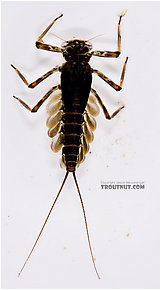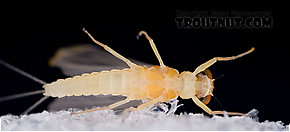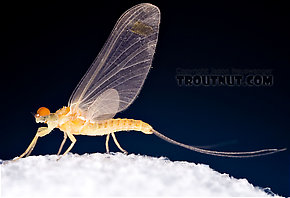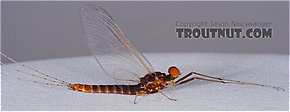Blog & Latest Updates
Fly Fishing Articles
Insects by Common Name


Little Maryatts
Scientific Names
| Match | Scientific Name |
| Epeorus | |
| Ephemerella dorothea dorothea | |
| Ephemerella invaria |
Like most common names, "Little Maryatt" can refer to more than one taxon. They're previewed below, along with 8 specimens. For more detail click through to the scientific names.
Mayfly Genus Epeorus
These are often called Little Maryatts.
There is remarkable variety of form and color within this prolific genus of fast-water mayflies. Different species are found across the country, and several cause good hatches. Fly anglers are likely to encounter the lesser species on occasion, too.
The best Epeorus hatch in the East is Epeorus pleuralis, the famous Quill Gordon, the first abundant large mayfly hatch of the year. Epeorus vitreus comes a little later and is important in both the East and Midwest.
In the West, Epeorus longimanus dominates in fast, high-altitude streams, while Epeorus albertae inhabits slower and lower waters.
The best Epeorus hatch in the East is Epeorus pleuralis, the famous Quill Gordon, the first abundant large mayfly hatch of the year. Epeorus vitreus comes a little later and is important in both the East and Midwest.
In the West, Epeorus longimanus dominates in fast, high-altitude streams, while Epeorus albertae inhabits slower and lower waters.
Male Epeorus pleuralis (Quill Gordon) Mayfly Dun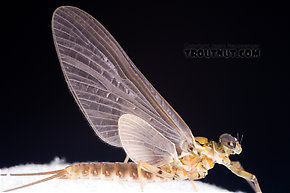 View 9 PicturesI kept this specimen after photographing it and it molted into a spinner in perfect condition, which I photographed here.
View 9 PicturesI kept this specimen after photographing it and it molted into a spinner in perfect condition, which I photographed here.
 View 9 PicturesI kept this specimen after photographing it and it molted into a spinner in perfect condition, which I photographed here.
View 9 PicturesI kept this specimen after photographing it and it molted into a spinner in perfect condition, which I photographed here.Male Epeorus pleuralis (Quill Gordon) Mayfly Spinner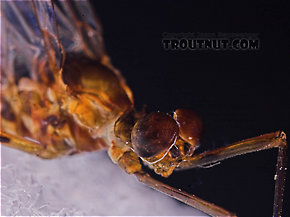 View 10 PicturesI spent (Spent: The wing position of many aquatic insects when they fall on the water after mating. The wings of both sides lay flat on the water. The word may be used to describe insects with their wings in that position, as well as the position itself.) most of the day looking for Epeorus pluralis duns or spinners without any luck on the major Catskill rivers. Finally in the evening I arrived at a small stream somebody had recommended, and when I got out of the car I was happy to find that I had parked in the middle of a cloud of male spinners.
View 10 PicturesI spent (Spent: The wing position of many aquatic insects when they fall on the water after mating. The wings of both sides lay flat on the water. The word may be used to describe insects with their wings in that position, as well as the position itself.) most of the day looking for Epeorus pluralis duns or spinners without any luck on the major Catskill rivers. Finally in the evening I arrived at a small stream somebody had recommended, and when I got out of the car I was happy to find that I had parked in the middle of a cloud of male spinners.
 View 10 PicturesI spent (Spent: The wing position of many aquatic insects when they fall on the water after mating. The wings of both sides lay flat on the water. The word may be used to describe insects with their wings in that position, as well as the position itself.) most of the day looking for Epeorus pluralis duns or spinners without any luck on the major Catskill rivers. Finally in the evening I arrived at a small stream somebody had recommended, and when I got out of the car I was happy to find that I had parked in the middle of a cloud of male spinners.
View 10 PicturesI spent (Spent: The wing position of many aquatic insects when they fall on the water after mating. The wings of both sides lay flat on the water. The word may be used to describe insects with their wings in that position, as well as the position itself.) most of the day looking for Epeorus pluralis duns or spinners without any luck on the major Catskill rivers. Finally in the evening I arrived at a small stream somebody had recommended, and when I got out of the car I was happy to find that I had parked in the middle of a cloud of male spinners.See 49 more specimens...
Mayfly Species Ephemerella dorothea dorothea
These are sometimes called Little Maryatts.
Ephemerella dorothea consists of two subspecies (Subspecies: Entomologists sometimes further divide a species into distinct groups called subspecies, which have two lower-case words on the end of their scientific name instead of one. The latter is the sub-species name. For example, Maccaffertium mexicanum mexicanum and Maccaffertium mexicanum integrum are two different subspecies of Maccaffertium mexicanum.), which both produce excellent action. Ephemerella dorothea dorothea is a small species of Sulphur in the East, and Ephemerella dorothea infrequens (formerly Ephemerella infrequens) is one of the two main Pale Morning Dun hatches of the West. The remainder of this page focuses on the dorothea dorothea subspecies (Subspecies: Entomologists sometimes further divide a species into distinct groups called subspecies, which have two lower-case words on the end of their scientific name instead of one. The latter is the sub-species name. For example, Maccaffertium mexicanum mexicanum and Maccaffertium mexicanum integrum are two different subspecies of Maccaffertium mexicanum.), and Ephemerella dorothea infrequens is discussed separately on its own page.
This is one of the most challenging mayfly hatches on Eastern waters. On many streams, it follows or overlaps hatches of the larger, lingering Ephemerella invaria.
This is one of the most challenging mayfly hatches on Eastern waters. On many streams, it follows or overlaps hatches of the larger, lingering Ephemerella invaria.
Ephemerella dorothea dorothea (Pale Evening Dun) Mayfly Nymph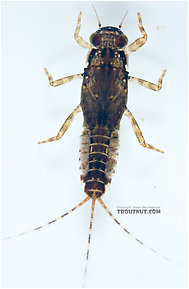 View 6 PicturesI keyed this nymph carefully under a microscope to check that it's Ephemerella dorothea.
View 6 PicturesI keyed this nymph carefully under a microscope to check that it's Ephemerella dorothea.
 View 6 PicturesI keyed this nymph carefully under a microscope to check that it's Ephemerella dorothea.
View 6 PicturesI keyed this nymph carefully under a microscope to check that it's Ephemerella dorothea.Mayfly Species Ephemerella invaria
These are very rarely called Little Maryatts.
This species, the primary "Sulphur" hatch, stirs many feelings in the angler. There is nostalgia for days when everything clicked and large, selective trout were brought to hand. There is the bewildering memory of towering clouds of spinners which promise great fishing and then vanish back into the aspens as night falls. There is frustration from the maddening selectivity with which trout approach the emerging duns--a vexing challenge that, for some of us, is the source of our excitement when Sulphur time rolls around.
Ephemerella invaria is one of the two species frequently known as Sulphurs (the other is Ephemerella dorothea). There used to be a third, Ephemerella rotunda, but entomologists recently discovered that invaria and rotunda are a single species with an incredible range of individual variation. This variation and the similarity to the also variable dorothea make telling them apart exceptionally tricky.
As the combination of two already prolific species, this has become the most abundant of all mayfly species in Eastern and Midwestern trout streams.
Ephemerella invaria is one of the two species frequently known as Sulphurs (the other is Ephemerella dorothea). There used to be a third, Ephemerella rotunda, but entomologists recently discovered that invaria and rotunda are a single species with an incredible range of individual variation. This variation and the similarity to the also variable dorothea make telling them apart exceptionally tricky.
As the combination of two already prolific species, this has become the most abundant of all mayfly species in Eastern and Midwestern trout streams.
Ephemerella invaria (Sulphur Dun) Mayfly Nymph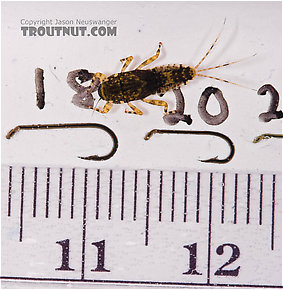 View 8 PicturesThis small Ephemerella invaria nymph was at least a month away from emergence.
View 8 PicturesThis small Ephemerella invaria nymph was at least a month away from emergence.
 View 8 PicturesThis small Ephemerella invaria nymph was at least a month away from emergence.
View 8 PicturesThis small Ephemerella invaria nymph was at least a month away from emergence.See 42 more specimens...
Top 10 Fly Hatches
Top Gift Shop Designs
Eat mayflies.
Top Insect Specimens
Miscellaneous Sites
Troutnut.com is copyright © 2004-2024 Jason
Neuswanger (email Jason). See my FAQ for information about use of my images.
 privacy policy
privacy policy

